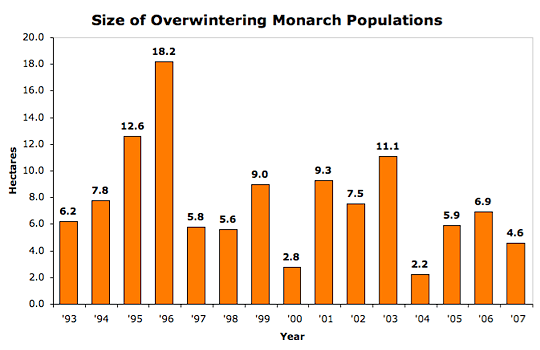Overwintering Monarch Population 2007-2008
Thursday, February 7th, 2008 at 4:05 pm by JimFiled under Monarch Population Status | Comments Off on Overwintering Monarch Population 2007-2008
It’s official – the monarch population numbers are low again. Measured at 4.61 hectares, this year’s overwintering population is the third lowest since detailed measures of all overwintering colonies began in 1993. The three lowest populations in this 15-year record have all occurred from 2000 to 2007 and the mean number of hectares for this interval is 6.3. The mean for the 7-year interval from 1993-1999 was 9.3.
On the surface, the difference between the last 8 years and the first 7 years would appear to suggest that the monarch population is declining. That may or may not be the case. At the moment, we don’t have the capacity to distinguish the impacts of anthropogenic factors (such as the loss of 100 million acres of breeding habitat due to the adoption of Roundup Ready crops, the annual loss of 2.2 million acres in the United States due to development, or the degradation of the overwintering sites) from those attributable to natural causes. The preponderance of evidence suggests that the monarch numbers are largely driven by climate and the lower mean for the last 8 years can be explained by less favorable climatic conditions than those in the 90s.
Based on the climate models I’ve been working on for the last several years, the lower numbers were not unexpected. The unrefined model predicted a total population of approximately 5 hectares, relatively close (as such predictions go) to the final number of 4.61 hectares. For previous discussion of this point see last month’s “Monarch Population Status” post.
How are the monarchs overwintering? It is now the 7th of February and all I can say to this question is: “so far so good”. The winter has been “normal” with most daytime temperatures in the 60s and nighttime temperatures in the 30s; there have been no reports of mortality due to freezes or storms. In another week, around Valentine’s Day appropriately enough, some of the monarchs will begin courting and mating; in the forth week of February some monarchs will begin the long flight back to the breeding grounds in the southern United States.
As to the coming season, will the monarch numbers be up or down? Much will depend on the conditions – primarily the temperatures and nectar availability – the returning monarchs encounter as they move north through Mexico and into Texas.
The numbers of hectares that represent the overwintering monarch populations from 1993 to present are given in the figure below.

Figure: Size of Overwintering Monarch Populations, 1993-2007.
We are indebted to many individuals who have spent long hours measuring the colonies over this 15-year interval, including Eligio Garcia Serano and, in recent years, Eduardo Rendon Salinas and his crews from World Wildlife Fund Mexico. We are also indebted to Carlos Galindo Leal who coordinates the monarch program for WWF-Mexico. The official report on the areas occupied by monarchs for each colony can be downloaded from the WWF-Mexico site (200K PDF file, in spanish): “Monitoreo de las colonias de hibernación de Mariposa Monarca: Superficie forestal de ocupación en diciembre de 2007”
[ Article revised 19 February 2008 ]


Sorry, comments for this entry are closed at this time.